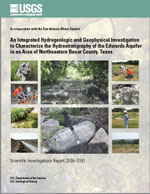An Integrated Hydrogeologic and Geophysical Investigation to Characterize the Hydrostratigraphy of the Edwards Aquifer in an Area of Northeastern Bexar County, Texas
Links
- More information: USGS Index Page (html)
- Document: Report (8.59 MB pdf)
- Plate: Sir2008 5181 Pl1 (26.7 MB pdf)
- Download citation as: RIS | Dublin Core
Abstract
In August 2007, the U.S. Geological Survey, in cooperation with the San Antonio Water System, did a hydrogeologic and geophysical investigation to characterize the hydrostratigraphy (hydrostratigraphic zones) and also the hydrogeologic features (karst features such as sinkholes and caves) of the Edwards aquifer in a 16-square-kilometer area of northeastern Bexar County, Texas, undergoing urban development. Existing hydrostratigraphic information, enhanced by local-scale geologic mapping in the area, and surface geophysics were used to associate ranges of electrical resistivities obtained from capacitively coupled (CC) resistivity surveys, frequency-domain electromagnetic (FDEM) surveys, time-domain electromagnetic (TDEM) soundings, and two-dimensional direct-current (2D-DC) resistivity surveys with each of seven hydrostratigraphic zones (equivalent to members of the Kainer and Person Formations) of the Edwards aquifer. The principal finding of this investigation is the relation between electrical resistivity and the contacts between the hydrostratigraphic zones of the Edwards aquifer and the underlying Trinity aquifer in the area. In general, the TDEM data indicate a two-layer model in which an electrical conductor underlies an electrical resistor, which is consistent with the Trinity aquifer (conductor) underlying the Edwards aquifer (resistor). TDEM data also show the plane of Bat Cave fault, a well-known fault in the area, to be associated with a local, nearly vertical zone of low resistivity that provides evidence, although not definitive, for Bat Cave fault functioning as a flow barrier, at least locally. In general, the CC resistivity, FDEM survey, and 2D-DC resistivity survey data show a sharp electrical contrast from north to south, changing from high resistivity to low resistivity across Bat Cave fault as well as possible karst features in the study area. Interpreted karst features that show relatively low resistivity within a relatively high-resistivity area likely are attributable to clay or soil filling a sinkhole. In general, faults are inferred where lithologic incongruity indicates possible displacement. Along most inferred faults, displacement was not sufficient to place different members of the Kainer or Person Formations (hydrostratigraphic zones) adjacent across the inferred fault plane. In general, the Kainer Formation (hydrostratigraphic zones V through VIII) has a higher resistivity than the Person Formation (hydrostratigraphic zones II through IV). Although resistivity variations from the CC resistivity, FDEM, and 2D-DC resistivity surveys, with mapping information, were sufficient to allow surface mapping of the lateral extent of hydrostratigraphic zones in places, resistivity variations from TDEM data were not sufficient to allow vertical delineation of hydrostratigraphic zones; however, the Edwards aquifer-Trinity aquifer contact could be identified from the TDEM data.
Study Area
| Publication type | Report |
|---|---|
| Publication Subtype | USGS Numbered Series |
| Title | An Integrated Hydrogeologic and Geophysical Investigation to Characterize the Hydrostratigraphy of the Edwards Aquifer in an Area of Northeastern Bexar County, Texas |
| Series title | Scientific Investigations Report |
| Series number | 2008-5181 |
| DOI | 10.3133/sir20085181 |
| Edition | Version 1.0 |
| Year Published | 2008 |
| Language | English |
| Publisher | U.S. Geological Survey |
| Publisher location | Reston, VA |
| Contributing office(s) | Texas Water Science Center |
| Description | Report: vi, 26 p.; Plate: 24 x 18 inches; Data Files |
| Time Range Start | 2007-08-01 |
| Time Range End | 2007-08-31 |
| Projection | Universal Transverse Mercator |
| Online Only (Y/N) | Y |
| Additional Online Files (Y/N) | Y |


